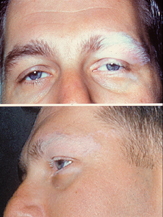An unusual cause of vertigo, tinnitus, and hyperacusis: Vogt-Koyanagi-Harada syndrome.
We
describe the case of a 36-year-old woman with a history of vitiligo who
presented with an insidious onset of neurologic, vestibular, ocular,
and auditory symptoms.
She had recently noted the onset of vertigo,
tinnitus, and hypersensitivity to sound.
Findings on audiometry were
within normal limits, although the patient reported some auditory
discomfort during the testing.
The patient had a history of bilateral
uveitis and peripheral neurologic symptoms.
She was diagnosed with
Vogt-Koyanagi-Harada (VKH) syndrome and started on corticosteroid
therapy.
Her neurologic, vestibular, ocular, and auditory symptoms
resolved.
VKH syndrome is an uncommon cause of vertigo and hearing loss,
but it should be considered in the differential diagnosis of patients
with autoimmunity-related inner ear symptoms.
Fuente: ENT - Ear Nose & Throat Journal
2012;Vol 91(12):E7 9
Nota de la redacción:de acuerdo a lo que se informa en http://commons.wikimedia.org/wiki/File:VKHS.jpg
La reacción inflamatoria provocada por la alteración del sistema inmunitario afecta a diversos órganos ricos en pigmentos (úvea, retina, y algunos pares craneales, causantes de la pérdida de audición).1
La enfermedad suele comenzar con un episodio febril seguido de uveitis bilateral asociada a coroiditis y neuritis óptica.
Puede acompañarse de hipoacusia neurosensorial y tinnitus, vitíligo, poliosis y alopecia, y en algunos casos incluso meningitis o encefalitis.
El primero en describirlo fue un médico árabe en torno al año 940 a. C. En 1906 Vogt y en 1929 Koyanagi describieron diversas modalidades del síndrome,en pacientes que presentaban iridociclitis, meningoencefalitis asociada a vitíligo, e hipoacusia.
Por la misma época (1926) Harada describe el cuadro de un paciente con uveítis bilateral asociada a encefalitis, adoptándose finalmente en 1951 la nomenclatura actual.
Los tres tipos principales del síndrome son:
- Tipo I: Patología ocular sin patología de oído o dermatológica.
- Tipo II: Patología ocular y al menos un síntoma en oídos o piel.
- Tipo III: Patología ocular con al menos dos síntomas en otra localización.
Referencias
- ↑ Ramírez-Rosales Arturo, Góngora-Rivera Fernando, García-Pompermayer Mario, Rodríguez-Robles Luis, Velarde-Magaña Germá: Enfermedad de Vogt-Koyanagi-Harada: Reporte de un caso. Rev Mex Neuroci 2012; 13(5): 275-280.
- The diagnostic clue in this patient is the telltale loss of hair coloring in the left eyebrow and eyelashes (poliosis) with contiguous vitiligo.
- Additional features of this syndrome—all of which this patient had—include panuveitis, retinal detachment, pinpoint retinal leaks on fluorescein angiography, and evidence of auditory and central nervous system dysfunction, including aseptic meningitis.
- Decreased visual acuity is the rule. The cause is uncertain, but immune-mediated damage of melanocyte-containing tissue seems likely.
- Long-term corticosteroid therapy usually halts further ocular damage and often improves vision.

No hay comentarios:
Publicar un comentario